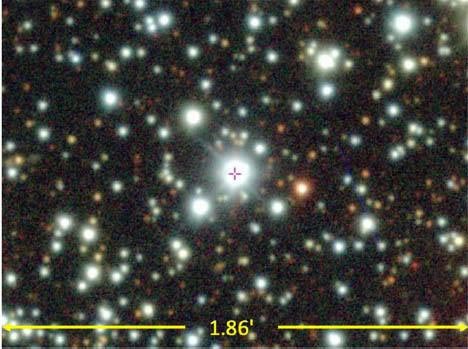Artist’s concept of a dark and mysterious object.
The Transiting Exoplanet Survey Satellite,
An optical/near-infrared image of the sky around the TESS Input Catalog (TIC) object TIC 400799224 (the crosshair marks the location of the object, and the width of the field of view is given in arcminutes). Astronomers have concluded that the mysterious periodic variations in the light from this object are caused by an orbiting body that periodically emits clouds of dust that occult the star. Credit: Powell et al., 2021
The astronomers studied TIC 400799224 with a variety of facilities including some that have been mapping the sky for longer than TESS has been operating. They found that the object is probably a binary star system, and that one of the stars pulsates with a 19.77 day period, probably from an orbiting body that periodically emits clouds of dust that occult the star. But while the periodicity is strict, the dust occultations of the star are erratic in their shapes, depths, and durations, and are detectable (at least from the ground) only about one-third of the time or less.
The nature of the orbiting body itself is puzzling because the quantity of dust emitted is large; if it were produced by the disintegration of an object like the asteroid Ceres in our solar system, it would survive only about eight thousand years before disappearing. Yet remarkably, over the six years that this object has been observed, the periodicity has remained strict and the object emitting the dust apparently has remained intact.
The team plans to continue monitoring the object and to incorporate historical observations of the sky to try to determine its variations over many decades.
Reference: “Mysterious Dust-emitting Object Orbiting TIC 400799224” by Brian P. Powell, Veselin B. Kostov, Saul A. Rappaport, Andrei Tokovinin, Avi Shporer, Karen A. Collins, Hank Corbett, Tamás Borkovits, Bruce L. Gary, Eugene Chiang, Joseph E. Rodriguez, Nicholas M. Law, Thomas Barclay, Robert Gagliano, Andrew Vanderburg, Greg Olmschenk, Ethan Kruse, Joshua E. Schlieder, Alan Vasquez Soto, Erin Goeke, Thomas L. Jacobs, Martti H. Kristiansen, Daryll M. LaCourse, Mark Omohundro, Hans M. Schwengeler, Ivan A. Terentev and Allan R. Schmitt, 8 December 2021, The Astronomical Journal.
DOI: 10.3847/1538-3881/ac2c81
